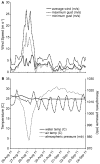Impact of Hurricane Irene on Vibrio vulnificus and Vibrio parahaemolyticus concentrations in surface water, sediment, and cultured oysters in the Chesapeake Bay, MD, USA
- PMID: 24847319
- PMCID: PMC4019861
- DOI: 10.3389/fmicb.2014.00204
Impact of Hurricane Irene on Vibrio vulnificus and Vibrio parahaemolyticus concentrations in surface water, sediment, and cultured oysters in the Chesapeake Bay, MD, USA
Abstract
To determine if a storm event (i.e., high winds, large volumes of precipitation) could alter concentrations of Vibrio vulnificus and V. parahaemolyticus in aquacultured oysters (Crassostrea virginica) and associated surface water and sediment, this study followed a sampling timeline before and after Hurricane Irene impacted the Chesapeake Bay estuary in late August 2011. Aquacultured oysters were sampled from two levels in the water column: surface (0.3 m) and near-bottom (just above the sediment). Concentrations of each Vibrio spp. and associated virulence genes were measured in oysters with a combination of real-time PCR and most probable number (MPN) enrichment methods, and in sediment and surface water with real-time PCR. While concentration shifts of each Vibrio species were apparent post-storm, statistical tests indicated no significant change in concentration for either Vibrio species by location (surface or near bottom oysters) or date sampled (oyster tissue, surface water, and sediment concentrations). V. vulnificus in oyster tissue was correlated with total suspended solids (r = 0.41, P = 0.04), and V. vulnificus in sediment was correlated with secchi depth (r = -0.93, P <0.01), salinity (r = -0.46, P = 0.02), tidal height (r = -0.45, P = 0.03), and surface water V. vulnificus (r = 0.98, P <0.01). V. parahaemolyticus in oyster tissue did not correlate with environmental measurements, but V. parahaemolyticus in sediment and surface water correlated with several measurements including secchi depth [r = -0.48, P = 0.02 (sediment); r = -0.97, P <0.01 (surface water)] and tidal height [r = -0.96, P <0.01 (sediment), r = -0.59, P <0.01 (surface water)]. The concentrations of Vibrio spp. were higher in oysters relative to other studies (average V. vulnificus 4 × 10(5) MPN g(-1), V. parahaemolyticus 1 × 10(5) MPN g(-1)), and virulence-associated genes were detected in most oyster samples. This study provides a first estimate of storm-related Vibrio density changes in oyster tissues, sediment, and surface water at an aquaculture facility in the Chesapeake Bay.
Keywords: Chesapeake Bay; Vibrio parahaemolyticus; Vibrio vulnificus; aquacultured oyster; estuary; sediment resuspension; storm event; wind event.
Figures
Similar articles
-
The effect of off-bottom versus on-bottom oyster culture on total and pathogenic Vibrio spp. abundances in oyster tissue, water and sediment samples.Int J Food Microbiol. 2022 Oct 16;379:109870. doi: 10.1016/j.ijfoodmicro.2022.109870. Epub 2022 Aug 5. Int J Food Microbiol. 2022. PMID: 35961160
-
Seasonal and Geographical Differences in Total and Pathogenic Vibrio parahaemolyticus and Vibrio vulnificus Levels in Seawater and Oysters from the Delaware and Chesapeake Bays Determined Using Several Methods.Appl Environ Microbiol. 2020 Nov 10;86(23):e01581-20. doi: 10.1128/AEM.01581-20. Print 2020 Nov 10. Appl Environ Microbiol. 2020. PMID: 32978135 Free PMC article.
-
High Salinity Relaying to Reduce Vibrio parahaemolyticus and Vibrio vulnificus in Chesapeake Bay Oysters (Crassostrea virginica).J Food Sci. 2017 Feb;82(2):484-491. doi: 10.1111/1750-3841.13584. Epub 2017 Jan 18. J Food Sci. 2017. PMID: 28099766
-
High salinity relay as a postharvest processing strategy to reduce vibrio vulnificus levels in Chesapeake Bay oysters (Crassostrea virginica).J Food Prot. 2011 Nov;74(11):1902-7. doi: 10.4315/0362-028X.JFP-11-152. J Food Prot. 2011. PMID: 22054191
-
Depuration of live oysters to reduce Vibrio parahaemolyticus and Vibrio vulnificus: A review of ecology and processing parameters.Compr Rev Food Sci Food Saf. 2022 Jul;21(4):3480-3506. doi: 10.1111/1541-4337.12969. Epub 2022 May 31. Compr Rev Food Sci Food Saf. 2022. PMID: 35638353 Review.
Cited by
-
Uncovering the geographical and host impacts on the classification of Vibrio vulnificus.Evol Appl. 2018 Feb 20;11(6):883-890. doi: 10.1111/eva.12602. eCollection 2018 Jul. Evol Appl. 2018. PMID: 29928297 Free PMC article.
-
Vibrio Ecology in the Neuse River Estuary, North Carolina, Characterized by Next-Generation Amplicon Sequencing of the Gene Encoding Heat Shock Protein 60 (hsp60).Appl Environ Microbiol. 2018 Jun 18;84(13):e00333-18. doi: 10.1128/AEM.00333-18. Print 2018 Jul 1. Appl Environ Microbiol. 2018. PMID: 29678912 Free PMC article.
-
Impact of Climate Change on Vibrio vulnificus Abundance and Exposure Risk.Estuaries Coast. 2018 Dec;41(8):2289-2303. doi: 10.1007/s12237-018-0424-5. Epub 2018 Jun 7. Estuaries Coast. 2018. PMID: 31263385 Free PMC article.
-
Rapid proliferation of Vibrio parahaemolyticus, Vibrio vulnificus, and Vibrio cholerae during freshwater flash floods in French Mediterranean coastal lagoons.Appl Environ Microbiol. 2015 Nov;81(21):7600-9. doi: 10.1128/AEM.01848-15. Epub 2015 Aug 28. Appl Environ Microbiol. 2015. PMID: 26319881 Free PMC article.
-
Co-Culturing Seaweed with Scallops Can Inhibit the Occurrence of Vibrio by Increasing Dissolved Oxygen and pH.Plants (Basel). 2025 Jan 23;14(3):334. doi: 10.3390/plants14030334. Plants (Basel). 2025. PMID: 39942895 Free PMC article.
References
-
- Avila L. A., Cangialosi J. (2011). “Tropical Cyclone Report: Hurricane Irene (AL092011), August 2011.” National Hurricane Center Summaries and Reports. Oxford, MD: NOAA
-
- Centers for Disease Control and Prevention [CDC]. (2005). Vibrio illnesses after Hurricane Katrina – multiple states, August–September 2005. MMWR Morb. Mortal. Wkly. Rep. 54 928–931 - PubMed
-
- DePaola A., Kaysner C. A. (2004). “Vibrio,” in Bacteriological Analytical Manual, Chap. 9 (Washington, DC: U.S. Food and Drug Administration; ).
-
- Environmental Protection Agency [EPA]. (2011). The Great Waters Program: Introduction to the Issues and Ecosystesms, Chesapeake Bay. Available at: http://www.epa.gov/oaqps001/gr8water/xbrochure/chesapea.html [accessed February 10, 2013]
LinkOut - more resources
Full Text Sources
Other Literature Sources
Molecular Biology Databases
Miscellaneous




